When it comes to handling date data in Excel, one common task I often encounter is converting months to quarters. Whether you’re analyzing sales data, financial reports, or project timelines, this process can be crucial for understanding quarterly trends and performance. In this guide, I’ll walk you through how I easily convert months to quarters in Excel.
Key Takeaways:
- Converting months to quarters helps me analyze trends and patterns more effectively over time.
- Using Excel’s CHOOSE function allows me to quickly map months to quarters, especially for non-standard fiscal years.
- Pivot Tables are a powerful tool to group date data by quarters without creating complex formulas.
- Ensuring that dates are in the correct format is crucial for accurate quarter calculations.
- Understanding fiscal years and adjusting formulas accordingly is essential for accurate financial analysis.
Table of Contents
Introduction to Excel Time-Saving Tricks
The Power of Mastering Date and Time Functions in Excel
Mastering date and time functions can drastically streamline my workflow in Excel. Various features and simple formulas help me manipulate and analyze temporal data with ease. Instead of manually calculating dates, times, and durations, using Excel’s built-in functions will save me both time and reduce the likelihood of errors.
In the context of business analysis, knowing how to quickly shift between days, months, and quarters means I’ll spend less time prepping data and more on insights.
Why Converting Months to Quarters Can Be a Game-Changer
Converting months to quarters can revolutionize the way I analyze data. By categorizing monthly data into quarterly segments, I can identify trends and patterns that aren’t visible on a month-by-month basis, providing me with a broader perspective on performance over time.
This conversion can be especially useful for comparing year-over-year growth, budgeting, and forecasting. It simplifies complex datasets, making them more digestible for stakeholders and facilitates more strategic decision-making by highlighting seasonal influences on data.
Understanding the Basics of Quarters in Excel
What Is a Fiscal Quarter?
A fiscal quarter is a three-month period within a company’s fiscal year used for financial reporting and forecasting. Unlike calendar quarters, which follow the regular year, fiscal quarters are defined by a company’s specific financial calendar and may start and end on any dates that make sense for the business’s operations.
For example, a company might operate on a fiscal year that begins in February and ends in January; thus, their Q1 would cover February to April. Understanding fiscal quarters is essential as they determine how I align my financial analysis and reporting periods for budget planning, taxation, and performance reviews.
The Significance of Analyzing Data Quarterly
Analyzing data on a quarterly basis is significant for it allows me to capture the ebb and flow of business performance throughout the year. Quarterly analysis helps in identifying trends that may be obscured on a monthly or annual scale. It aligns with many financial reporting standards, making it easier for me to communicate with stakeholders using a familiar timeframe.
Additionally, it provides timely updates on progress toward annual goals, enabling me to make strategic adjustments as necessary, ensuring that I don’t wait until year-end to gauge success or address issues.
Step-by-Step Guide to Convert Months to Quarters
Preparing Your Dataset for Conversion
Before converting monthly data into quarters, it’s important that I prepare my dataset to ensure a smooth transition. I begin by verifying the completeness and accuracy of the monthly data. Next, I ensure that all dates are in a consistent format that Excel recognizes, such as DD/MM/YYYY or MM/DD/YYYY.
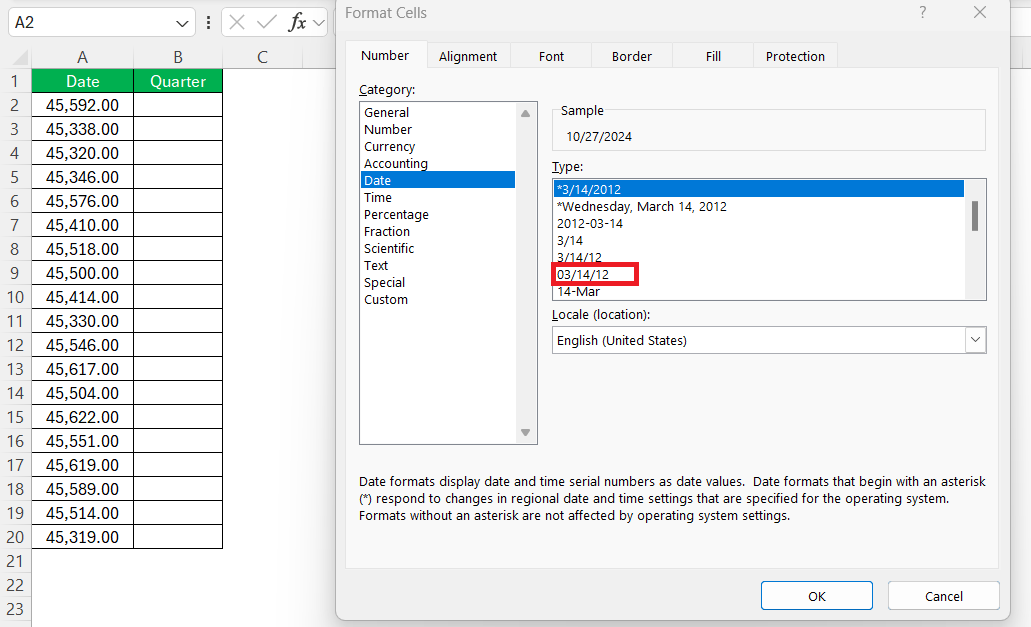
If I encounter any missing data points, I decide whether to omit the quarter from my analysis or if I should use zero or a placeholder. It’s also important to note the distinction between calendar and fiscal quarters, as this may influence how I categorize each month.
By taking these preparatory steps, I set myself up for a successful conversion process.
Method 1 – Using Month Formula for Quick Conversion
To swiftly convert months to quarters in Excel, I utilize straightforward formulas. If my financial year aligns with the calendar year, I start with the =MONTH() function to extract the month number from a date. Then, I divide this by 3 and apply the =ROUNDUP() function to determine the quarter each month falls into.
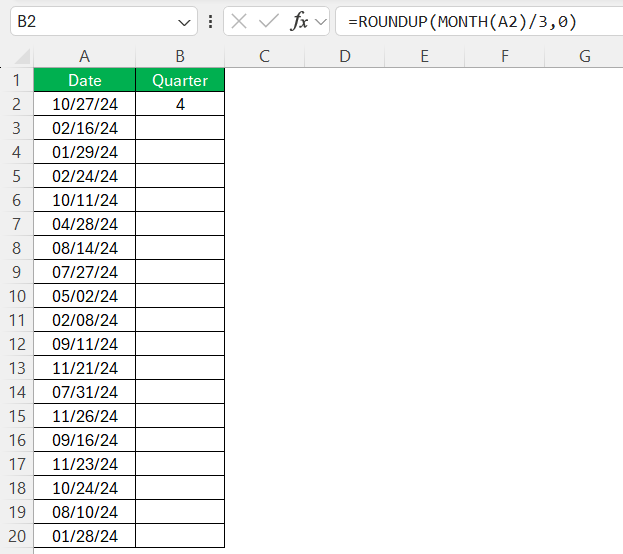
I can further refine this by concatenating text to display the quarter as “Q1”, “Q2”, etc. This is achieved by the formula = “Q” & ROUNDUP(MONTH(date)/3, 0) for simplicity or = “Q” & INT((MONTH(date)+2)/3) for a month-to-quarter only conversion.
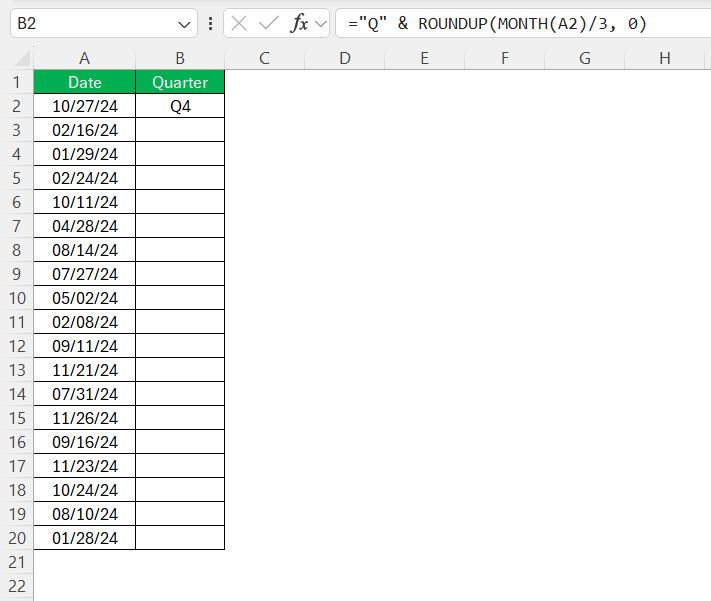
Once the formula is set, I drag it down the column to apply it across all dates.
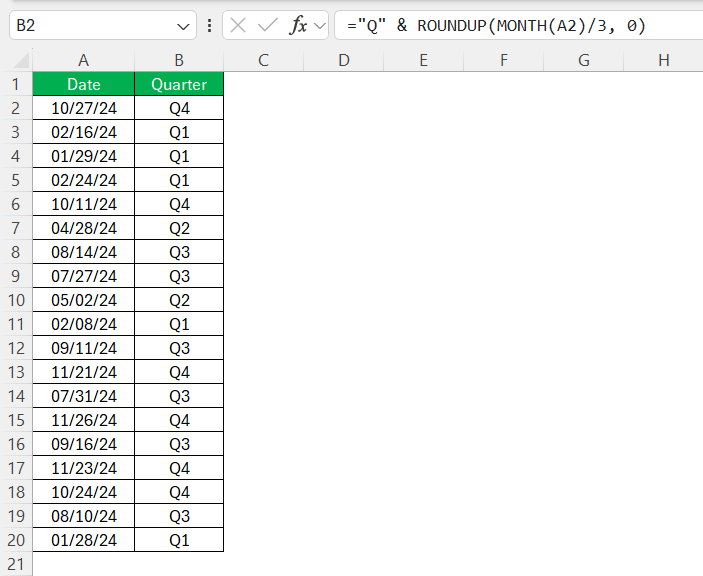
Remembering to check date formats is crucial, as proper conversion requires that dates are stored as actual dates and not as text.
Method 2 – Using the CHOOSE formula
One of the simplest methods I use to convert months to quarters in Excel is the CHOOSE function. Let’s say I have a date in cell A2 and I want to find out which quarter it falls into. I use the MONTH function to extract the month from the date and the CHOOSE function to map that month to the corresponding quarter.
Here’s the formula:
=CHOOSE(MONTH(A2), 1, 1, 1, 2, 2, 2, 3, 3, 3, 4, 4, 4)
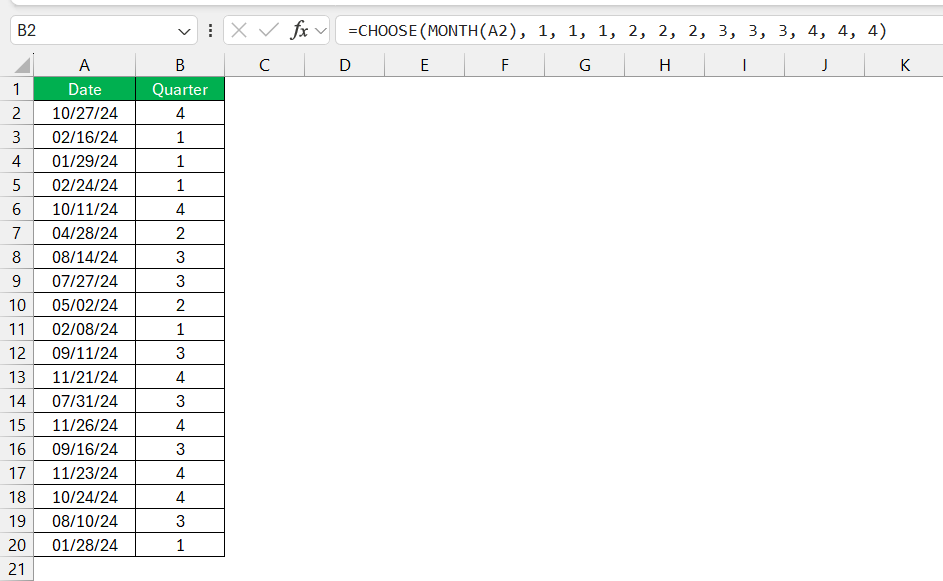
This formula breaks down as follows:
- MONTH(A2) retrieves the month number from the date in cell A2.
- CHOOSE takes that month number and assigns it to the corresponding quarter (1 for Q1, 2 for Q2, etc.).
To convert months to quarters for a fiscal year starting in March using the CHOOSE function, the mapping of months to quarters will change. In this case, the fiscal quarters would look like this:
- Q1: March, April, May
- Q2: June, July, August
- Q3: September, October, November
- Q4: December, January, February
To reflect this in Excel using the CHOOSE function, here’s how I modify the formula:
=CHOOSE(MONTH(A2), 4, 4, 1, 1, 1, 2, 2, 2, 3, 3, 3, 4)
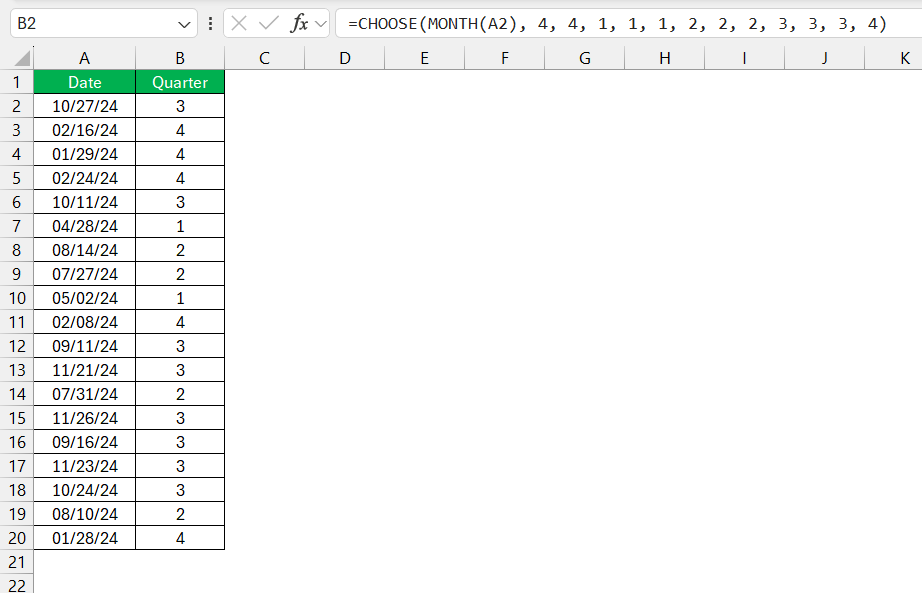
Method 3 – Pivot Tables
If I need to analyze my data by quarters quickly, I often turn to Pivot Tables. When working with date fields, Pivot Tables allow me to group data by quarters with just a few clicks. Here’s how I do it:
STEP 1: Select my data and create a Pivot Table (Insert > Pivot Table).
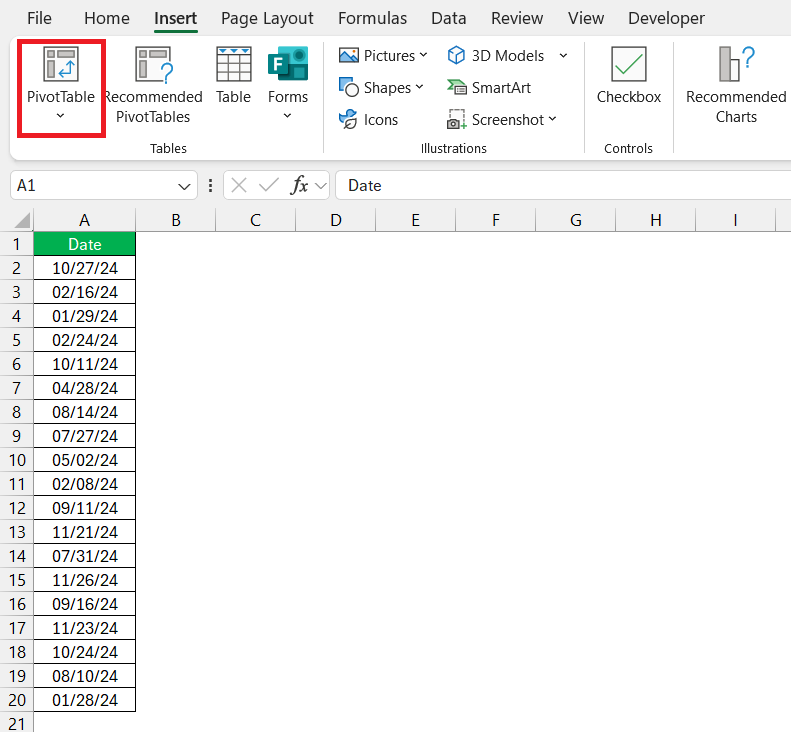
STEP 2: Drag the date field into the Rows area twice.
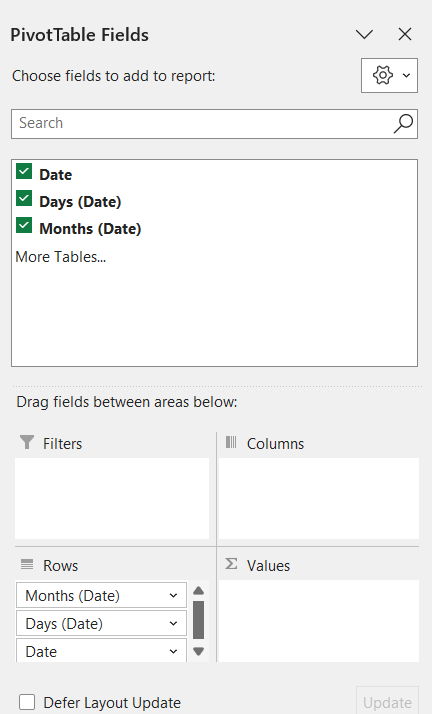
STEP 3: Right-click on one of the dates in the Pivot Table and select Group.
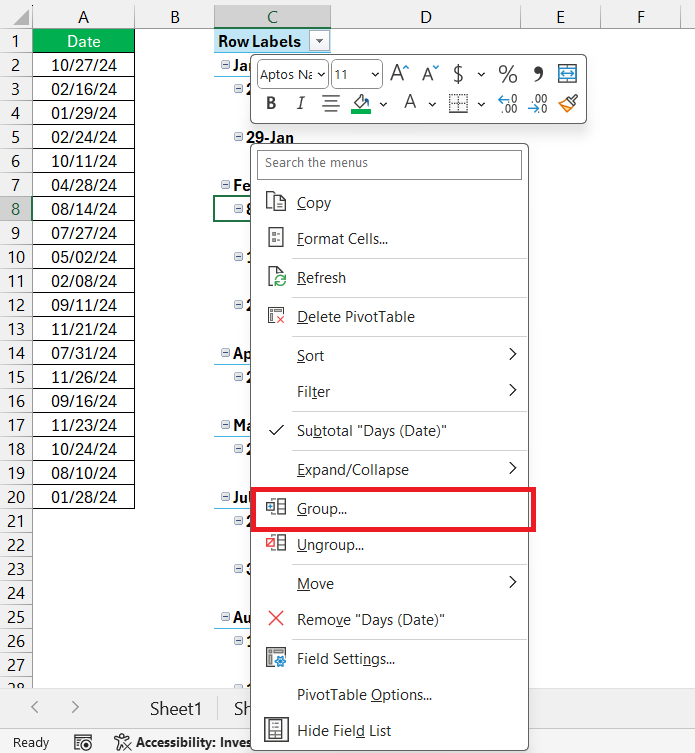
STEP 4: In the Grouping window, choose Days and Quarters.
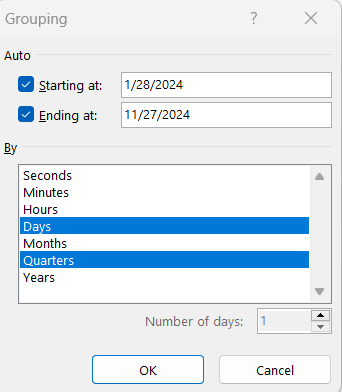
Now, I can summarize my data by quarter without needing to create a separate formula!
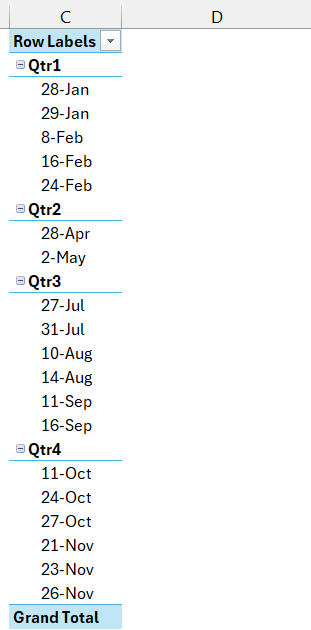
Common Pitfalls and How to Avoid Them
Ensuring Accurate Quarter Calculations
To ensure accurate quarter calculations, I triple-check that all dates are in the correct format and that my formula accounts for my company’s specific fiscal year if it doesn’t align with the calendar year. When I adjust formulas for a fiscal year that starts in a month other than January, I tweak the calculation by taking into account the offset from the calendar year.
For example, if February is the start of Q1 in fiscal terms, then the formula adapts by adding or subtracting the necessary number of months. Additionally, I’m mindful of leap years and adjust my calculations accordingly to account for the extra day in February, ensuring no quarter seems shorter or longer than it should be.
Troubleshooting Common Errors When Converting Dates
When converting dates, I often encounter common errors that can be resolved with a few checks and adjustments. For instance, if Excel doesn’t recognize the dates in my dataset (because they’re formatted as text), my formulas won’t work correctly.
I remedy this by ensuring that all dates are in a recognizable date format—an issue I can quickly identify by toggling Show Formulas mode with Ctrl+`.
Another frequent error occurs when leap years or a company’s non-standard fiscal calendar are not accounted for, resulting in miscalculated quarters. To prevent or fix these errors, I review leap years and custom fiscal calendars, making sure my formulas accurately reflect these special cases.
Real-World Applications of Month-to-Quarter Conversion
Financial Reporting and Forecasting
In financial reporting and forecasting, converting months to quarters is an indispensable skill. Utilizing quarters offers me a structured timeline for presenting financial results and predictions that are aligned with the business cycles and seasons, affecting performance.
For quarterly reports, I summarize income statements, balance sheets, and cash flow statements to provide an aggregated view of the company’s financial position. Forecasting also becomes more manageable, as I can project future earnings and expenses within the same quarter framework.
This method leads to the creation of more consistent, reliable plans that stakeholders and investors can easily interpret.
Sales Analysis and Trend Detection
Sales analysis and trend detection benefit significantly from the month-to-quarter conversion in Excel. By organizing sales data into quarters, I can detect cyclical trends, such as seasonal effects on customer buying behavior, and adjust my strategies accordingly.
Moreover, it simplifies the comparison of sales performance across different years. Quarterly analysis also aids in managing inventory by highlighting periods of high or low demand, which informs procurement and stock management.
This higher-level view can also reveal long-term sales trends that monthly data may not illuminate, enabling more intelligent, data-driven forecasting and planning.
FAQ: Fast Answers to Your Quarter Conversion Queries
How to convert months into quarters in Excel?
To convert months into quarters in Excel, use the formula ="Q" & INT((MONTH(A2)+2)/3), which will group months into their respective quarters as “Q1”, “Q2”, “Q3”, or “Q4”. Place the formula in a cell next to my date data, and drag it down to convert the entire column.
How do I ensure my conversion aligns with fiscal year definitions?
To align my conversion with fiscal year definitions, I customize my formulas based on the company’s fiscal calendar. If the fiscal year starts in a month other than January, I use the CHOOSE function to correspond each month to the correct quarter. For instance, =CHOOSE(MONTH(A2),4,1,1,1,2,2,2,3,3,3,4,4) for a fiscal year ending in January. Always verify that the fiscal quarters reflect the company’s reporting periods.
Can I convert months to quarters for multiple years at once?
Yes, I can convert months to quarters for multiple years at once in Excel. By using a formula like ="Q" & INT((MONTH(A2)+2)/3) & "-" & YEAR(A2), I not only group data by quarter but also append the year, ensuring accuracy across a multi-year range. This is done for all applicable cells in a continuous range simultaneously.
What is the best practice for using converted quarters in dashboards and charts?
The best practice for using converted quarters in dashboards and charts is consistent use of quarter formats across all data visualizations for coherence. I create a standard legend for quarters, ensure that all date-related data is converted and displayed in quarter format, and use PivotCharts or slicers for interactive elements. This approach simplifies the visualization of time-based trends and comparisons, making the dashboard or chart intuitive and insightful.
How to find or get quarter from a given date in Excel?
To find or get the quarter from a given date in Excel, use the formula ="Q" & ROUNDUP(MONTH(A1)/3, 0). Enter the formula in a cell adjacent to the date, and it will return the quarter “Q1”, “Q2”, “Q3”, or “Q4”. I can drag the formula down to apply it to multiple dates in a column to get quarters for each one.
John Michaloudis is a former accountant and finance analyst at General Electric, a Microsoft MVP since 2020, an Amazon #1 bestselling author of 4 Microsoft Excel books and teacher of Microsoft Excel & Office over at his flagship MyExcelOnline Academy Online Course.







